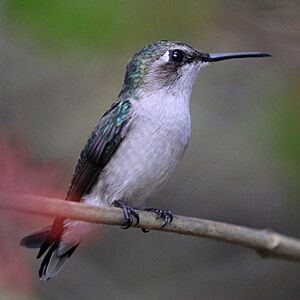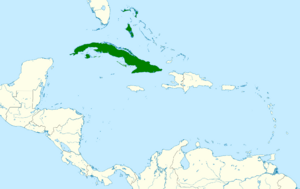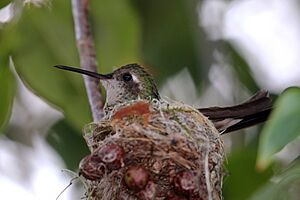Cuban emerald facts for kids
Quick facts for kids Cuban emerald |
|
|---|---|
 |
|
| Male | |
 |
|
| Female both R. r. recordii at Palpite, Cuba |
|
| Conservation status | |
| Scientific classification | |
| Genus: |
Riccordia
|
| Species: |
ricordii
|
 |
|
| Range of C. ricordii | |
| Synonyms | |
|
Chlorostilbon ricordii |
|
The Cuban emerald (Riccordia ricordii) is a small, shimmering hummingbird. It belongs to a group of hummingbirds called "emeralds." You can find this beautiful bird living in the Bahamas and Cuba.
Contents
Understanding the Cuban Emerald's Family Tree
Scientists group animals together based on how they are related. This helps us understand them better. The Cuban emerald used to be in a group called Chlorostilbon.
However, after new studies, many scientists decided to move it. They now place it in a different group called Riccordia. This shows how our understanding of nature can change as we learn more!
What Does a Cuban Emerald Look Like?
Cuban emeralds are tiny birds. Males are about 10.5 to 11.5 centimeters long. Females are a bit smaller, around 9.5 to 10.5 centimeters. They weigh between 2.5 and 5 grams, which is less than a nickel!
Males have a short, slightly curved bill. The tip is black, and the bottom part is red. They have a small white spot behind each eye. Their top feathers are a shiny dark green, almost bronze. Their bellies are mostly a bright metallic green. Their tail is deeply forked, like a "V" shape.
Females look similar on top. They also have a white spot behind their eye, but it's a bit longer. Their bellies are mostly brownish-gray. Their tail is not as deeply forked as the male's.
Where Do Cuban Emeralds Live?
The Cuban emerald lives on the main island of Cuba. It also lives on the large Isla de la Juventud and other smaller islands nearby. You can also find them on islands in the Bahamas, like Grand Bahama and Andros.
These birds like many different kinds of wooded areas. In Cuba, they live in both dry and wet open forests. In the Bahamas, they prefer pine woods and coastal areas. You might even spot them in parks, gardens, and farms! They can live from sea level up to high mountains.
How Do Cuban Emeralds Behave?
Moving Around
Cuban emeralds usually stay in one area. They don't travel far. Sometimes, they move to different elevations on mountains. They have been seen in Florida a few times. However, scientists are still checking if those sightings are official.
What Do They Eat?
Cuban emeralds love to drink nectar from flowers. They visit many different flowering trees and bushes. They usually look for food close to the ground, under 6 meters high.
They also eat small insects. They catch insects by flying out from a perch. Sometimes, they even pick insects from spider webs!
Building Nests and Raising Chicks
Cuban emeralds can lay eggs at any time of year. But in Cuba, they mostly breed between April and July. The female builds a cup-shaped nest. She uses plant fibers, moss, and bark. She holds it all together with spider webs. Often, she covers the nest with lichen and bits of bark to hide it.
She places the nest in a tree fork, usually 1 to 4 meters above the ground. The female lays two eggs. She sits on them for about 15 to 16 days until they hatch. The young birds are ready to fly about 19 to 22 days after hatching.
What Sounds Do They Make?
Male Cuban emeralds have a high-pitched song. It sounds like a fast, rolling series of "slee" notes and metallic sputtering sounds. Females make a high-pitched "seeeee" call when they fly. They also make a buzzy "zzzir" sound and "chi-di-dit" calls.
Is the Cuban Emerald Safe?
The IUCN (International Union for Conservation of Nature) has listed the Cuban emerald as a species of "Least Concern." This means they are not currently in danger of disappearing. We don't know exactly how many there are or if their numbers are changing.
However, they live in a large area, and no big threats have been found. They are common in most places they live. They also seem to do well in areas changed by humans, like gardens.




